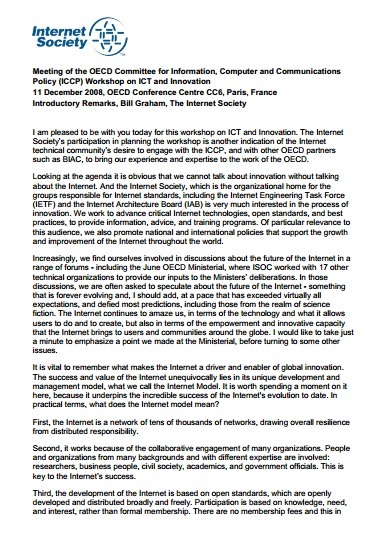Meeting of the OECD Committee for Information, Computer and Communications Policy (ICCP) Workshop on ICT and Innovation
11 December 2008, OECD Conference Centre CC6, Paris, France
Introductory Remarks, Bill Graham, The Internet Society
I am pleased to be with you today for this workshop on ICT and Innovation. The Internet Society’s participation in planning the workshop is another indication of the Internet technical community’s desire to engage with the ICCP, and with other OECD partners such as BIAC, to bring our experience and expertise to the work of the OECD.
Looking at the agenda it is obvious that we cannot talk about innovation without talking about the Internet. And the Internet Society, which is the organizational home for the groups responsible for Internet standards, including the Internet Engineering Task Force (IETF) and the Internet Architecture Board (IAB) is very much interested in the process of innovation. We work to advance critical Internet technologies, open standards, and best practices, to provide information, advice, and training programs. Of particular relevance to this audience, we also promote national and international policies that support the growth and improvement of the Internet throughout the world.
Increasingly, we find ourselves involved in discussions about the future of the Internet in a range of forums – including the June OECD Ministerial, where ISOC worked with 17 other technical organizations to provide our inputs to the Ministers’ deliberations. In those discussions, we are often asked to speculate about the future of the Internet – something that is forever evolving and, I should add, at a pace that has exceeded virtually all expectations, and defied most predictions, including those from the realm of science fiction. The Internet continues to amaze us, in terms of the technology and what it allows users to do and to create, but also in terms of the empowerment and innovative capacity that the Internet brings to users and communities around the globe. I would like to take just a minute to emphasize a point we made at the Ministerial, before turning to some other issues.
It is vital to remember what makes the Internet a driver and enabler of global innovation. The success and value of the Internet unequivocally lies in its unique development and management model, what we call the Internet Model. It is worth spending a moment on it here, because it underpins the incredible success of the Internet’s evolution to date. In practical terms, what does the Internet model mean?
First, the Internet is a network of tens of thousands of networks, drawing overall resilience from distributed responsibility.
Second, it works because of the collaborative engagement of many organizations. People and organizations from many backgrounds and with different expertise are involved: researchers, business people, civil society, academics, and government officials. This is key to the Internet’s success.
Third, the development of the Internet is based on open standards, which are openly developed and distributed broadly and freely. Participation is based on knowledge, need, and interest, rather than formal membership. There are no membership fees and this in itself is important. The Internet community has always worked to reduce barriers and encourage broad participation.
And finally, underlying the Internet model are widely supported key architectural principles, such as the “end-to-end principle.” These encourage the creation and global deployment of innovative, successful, and often surprising applications. And those who create applications don’t need permission to deploy them on the Internet. More importantly, users themselves choose which applications suit their needs, hopefully with no intermediate filtering.
In short, the Internet model is a robust, flexible, adaptive system, whose value is greater than the sum of its parts. We believe it is vital to support that model to ensure the Internet remains an engine of innovation.
But we must do other things as well to ensure that we achieve maximum benefit from innovation in the Internet economy.
Invention can be a solitary endeavor. We’re all familiar with the Hollywood image of the single scientist or engineer working late into the night when suddenly inspiration strikes. In contrast, innovation – which turns inventions into products and services and gets them to market – is ALWAYS a collaborative effort that requires the sharing of ideas and teamwork – and that is facilitated by the Internet.
While patents and copyrights can promote and protect invention, they can also be applied negatively in ways that hinder productive knowledge sharing and further innovation. We’ve seen examples in the area of Internet and Web standards where developments are delayed by prolonged court battles.
I hope that as we look at ways to foster collaboration and innovation during this workshop, we can touch on how patent and copyright laws and practices can be responsibly and fairly updated for the Internet Age, fostering an effective balance between the rights of creators and innovators and the needs of users, who are all potential innovators themselves.
As Jonathan Zittrain explains in his book, “The Future of the Internet–And How to Stop It,” we are at a critical point in the development of the Internet. If we make the wrong policy choices in how we balance rights and needs, or in how we seek to build trust and enhance confidence in the networks, the Internet could be “locked down.” That would effectively stop development of a new wave of applications – Web 2.0, the Semantic Web, Cloud computing – just as it’s getting started.
Today’s workshop addresses many issues of great importance. But as we delve more deeply into technical and policy aspects of the innovation strategy, let us remember that the Internet is more than just a communications network, it is an incredibly powerful platform for innovation. We must all work together to support the Internet model and to create the policy environment to ensure it continues to be that platform in the future.
Thank you
